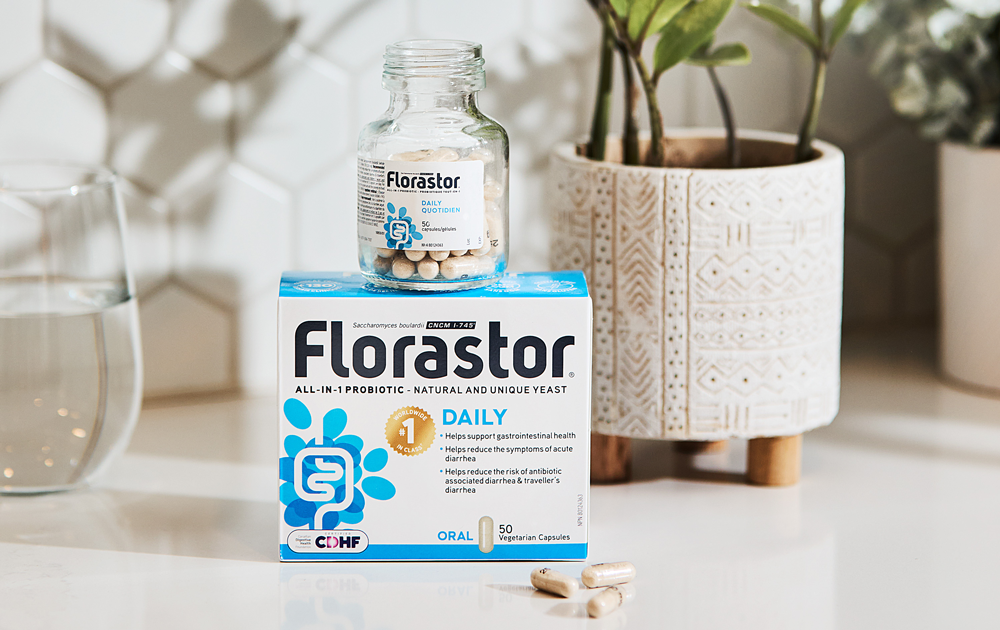What is the role of Florastor in H pylori eradication?

H. pylori is one of the most common bacterial infections globally with an estimated prevalence of up to 30% in Canada although the rates may be even higher in certain communities including among those who have immigrated from South America, Africa and Asia.
It is known to reside within the stomach lining of humans and is uniquely able to adapt to the acidic conditions while avoiding detection by the immune system owing to the manner in which it imbeds itself.
Some notable risk factors for infection include:
· Lower socioeconomic status
· Smoking
· Crowded living conditions
· Family history of peptic ulcer and/or gastric cancer
· Low fruit consumption
Guidelines around the treatment for H pylori are ever evolving owing to growing resistance to commonly used antibiotics like clarithromycin and levofloxacin.
Optimal treatment approach takes into consideration multiple factors including a patient’s preferences and prior antibiotic use.
In all cases, the confirmation of H pylori eradication is an important end target because it has been robustly demonstrated to reduce future gastric cancer risk.
This brings us to the focal point of today’s discussion centered on a potentially supportive role of S. Boulardii in the treatment process.
Let’s examine some findings from studies in this area over the five years:
A recently published trial out of Scientific Reports found S. boulardii enhanced the eradication rate of triple therapy antibiotic treatment and reduced dyspepsia symptoms compared to triple therapy alone.
The H pylori eradication rate for triple therapy was found to be 65.2% but the combination of triple therapy with Saccharomyces boulardii increased the eradication success rate to 75%.
Looking at aggregate data, we have a 2025 meta-analysis out of Frontiers In Cellular And Infection Microbiology which considered a total of 19 trials including >5,000 H. pylori cases.
The inclusion of S. boulardii in combination with traditional antibiotic therapy was found to increase eradication rate by 11% while decreasing adverse effects of antibiotic treatment, including nausea and stomach distension, by >50%.
When considering the negative consequences of antibiotic use on the gut microbiome, a 2020 trial out of the European Journal Of Clinical Microbiology found that parallel use of S. Boulardii in patients underdoing conventional treatment for H Pylori led to a more favourable microbiome profile ( greater diversity, greater abundance of favourable species) upon treatment completion.
Generally speaking the favourable influence of S Boulardii on eradication rates is found primarily when it is used in combination with standard triple antibiotic therapy.
When considering bismuth quadruple therapy, eradication rates are generally higher and thus there is less room for a synergistic influence of S. Boulardii.
What we do still see, however, is a positive influence on the reduction of diaarrhea, constipation and distension symptoms - as confirmed by a 2024 meta-analysis looking specifically at S. Boulardii use alongside quadruple therapy.
Are similar results found in children?
They are!
A 2023 systematic review and meta-analysis out of BMC Infectious Diseases looking at 15 controlled trials and >2,100 patients determined that S. Boulardii use in children receiving standard triple antibiotic therapy for H Pylori improved eradication rates by ~15% compared to triple therapy alone.
When considering all potential adverse events in children including diarrhea, nausea, vomiting, abdominal pain, poor appetite etc a 68% reduction in risk was observed when S. Boulardii was used in conjunction with triple therapy rather than triple therapy alone.
Putting It All Together
The totality of scientific evidence supporting the use of S boulardii in conjunction with different types of eradication therapy for H pylori is compelling and multi-faceted.
It follows logically that S Boulardii use in this context is well supported and explicitly recommended by numerous reputable organizations including:
- American Gastroenterology Association: Clinical practice guidelines on the role of probiotics in the management of gastrointestinal disorders 20201
- ESPGHAN: Probiotics for the management of paediatric gastrointestinal disorders 20221
- World Gastroenterology Organisation: Global guidelines probiotics and prebiotics 20231
- Maastricht V/Florence Consensus Report: Recommendations on H. pylori management 20162
In summary, the benefits that we might expect from their co-utilization depend on the treatment choice and potentially include enhanced eradication rates alongside a minimization of gastrointestinal symptoms and microbiome perturbations during and after treatment.
Sources
- https://nccid.ca/debrief/helicobacter-pylori/#:~:text=In%20Canada%2C%20the%20overall%20prevalence,is%20between%2020%2D30%25.
- https://pubmed.ncbi.nlm.nih.gov/39824392/
- https://www.nature.com/articles/s41598-024-63894-z
- https://www.frontiersin.org/journals/cellular-and-infection-microbiology/articles/10.3389/fcimb.2025.1441185/full
- https://bmcinfectdis.biomedcentral.com/articles/10.1186/s12879-023-08896-4
- https://pubmed.ncbi.nlm.nih.gov/32125555/
- https://www.frontiersin.org/journals/medicine/articles/10.3389/fmed.2024.1344702/full




